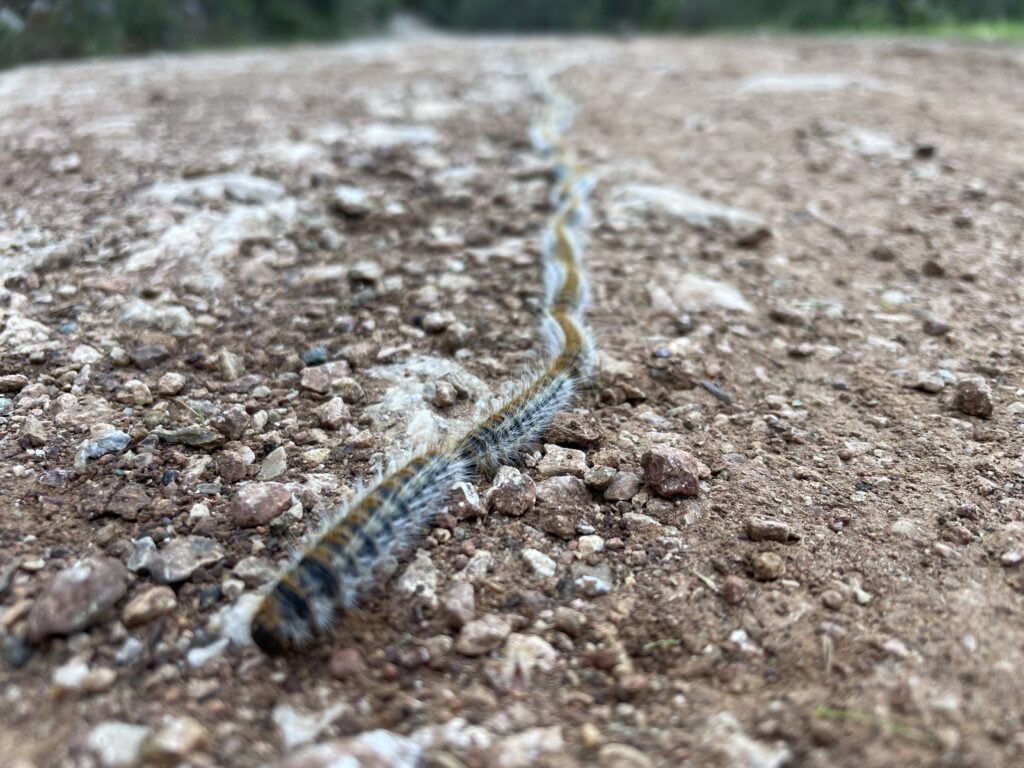This article was written for Fethiye Times by Steve Parsley
If you enjoy walking in the forests in Türkiye you will probably have noticed what look like cotton pods in the branches of the pine trees and perhaps even be aware of what they are.
Each one is a nest made by larvae of the brown pine processionary moth, which then spend the winter months up in the tree tops getting ready for spring.
And it’s usually around March or April when the mature caterpillars form up into the long lines which give the species their name. The chains of caterpillars – sometimes made up of 300 or more – then begin their march in a hunt for soft ground to form the chrysalises which, in time, become the next generation of adult moths.
But, in the meantime, they also become a potential danger to both humans and animals as the caterpillars use urticating hairs along the length of their bodies as a defence mechanism against predators.
But how much of a threat do they really present, how virulent is the toxin (Thaumetopoein) and what should you do if you or your dog or cat come into contact with it?
Research tells us the following:
Are the caterpillars really a genuine threat?
Yes – or at least they are when they have reached the latter stages of maturity.
When the new “cotton pods” first begin to appear in mid-winter, the caterpillars are in the early stages of development and have not yet grown their urticating hairs. They are therefore pretty much benign at this stage. However, be aware old nests left over from last year are a different story as they may contain hairs shed during the previous season.
However, once the caterpillars have formed their marching lines and leave the trees in search of softer ground that they need to burrow and pupate, they become a much more dangerous proposition. By now, the urticating hairs along the length of their bodies are fully developed and capable of delivering a potent toxin.
How is the toxin delivered?
If a pine processionary caterpillar believes it’s in danger from a predator, it shares a similar characteristic with a tarantula. It can actually eject some of the hairs from its body in the general direction of the perceived threat. Any which come into contact with exposed skin, nostrils or eyes can cause severe irritation.
However, usually, the toxin is delivered through an animal (or person) touching the caterpillar in some way. Like a nettle, the hairs can cause itching, prompting the victim to scratch, potentially then moving the toxin to other parts of the body.
A dog licking an infected paw for example can also ingest or inhale the toxin, potentially causing problems in the gut or the respiratory system.
How lethal is the toxin
Obviously, the victim’s reaction – human or animal – will depend on how many hairs they have come into contact with but it’s also true the toxin can have a different impact on individual victims. Like a bee sting, some may only experience a mild irritation which others risk an allergic reaction or even anaphylactic shock.
There are also recorded cases of contact with the caterpillar hairs leading to necrosis, which means tissue in the affected area dies and has to be cut away to prevent further infection.
If the inflammation or infection gets into the gut or respiratory system then it can ultimately prove fatal.
Are there any effective treatments?
Should you or your pet accidentally touch a pine processionary caterpillar, it’s recommended that you wash the affected area immediately with copious amounts of water. If the hairs have entered the mouth then, you will need to be careful not to wash them down the throat as that may cause additional inflammation along the gut.
Some sources have suggested citric acid from fruits like lemons and limes help while an ancient remedy was a salve made by mixing the horse-heal plant with oil and wine. However, if your dog or cat is showing signs of distress such as excessive drooling or salivating, then emergency treatment at the nearest vet is probably best.
If you detect any redness on the skin, ointments are not necessarily the answer as your pet will lick them off, potentially ingesting any of the microscopic hairs left behind. A protective collar may be necessary to prevent them doing so which also probably means a visit to the vet.
How do I avoid them and stay safe?
The obvious answer is to avoid the forest between the end of March until the end of June, when most of the caterpillars will have completed the dangerous phase of their lifespan and be safely underground.
However, if you find it difficult to stay away from your favourite haunts for that long, then its best to ensure you carry plenty of water, wear stout footwear and clothing (boots and long trousers, not flip-flops and shorts) and keep your pets close.
If you walk surfaced or hard-packed tracks, the lines of caterpillars are quite easy to spot even from a distance so keeping clear of them is relatively simple. However, dogs should probably still be on a lead as their natural curiosity risks them having a sniff before you can intervene, particularly if they’re a few metres ahead of you.
If a line of caterpillars crosses your path completely, you may want to consider turning back or stepping over them. The latter may be safe enough if no contact is made but be aware the caterpillars can eject hairs towards a perceived threat if they feel sufficiently vulnerable.
Weather also seems to affects the caterpillars’ behaviour. Anecdotal evidence suggests, although they may not be totally absent, there may be fewer around when it’s cold or wet and more of them when it’s warm and dry.
Sources:
Pine processionary – Wikipedia








